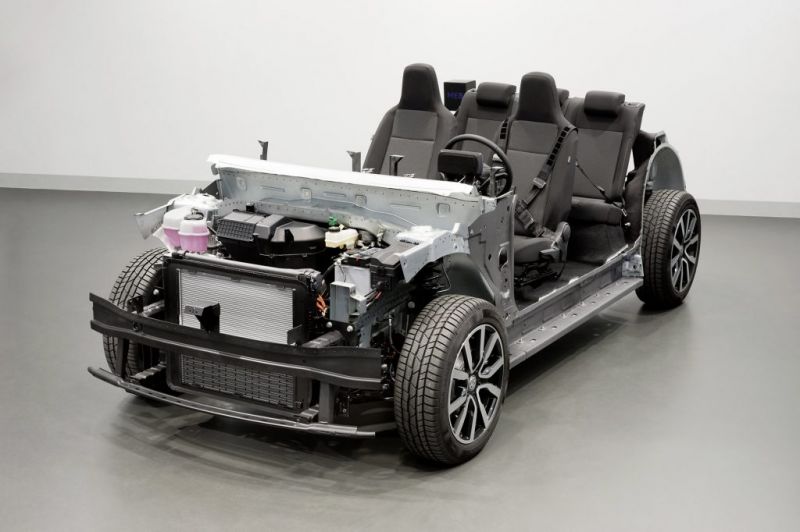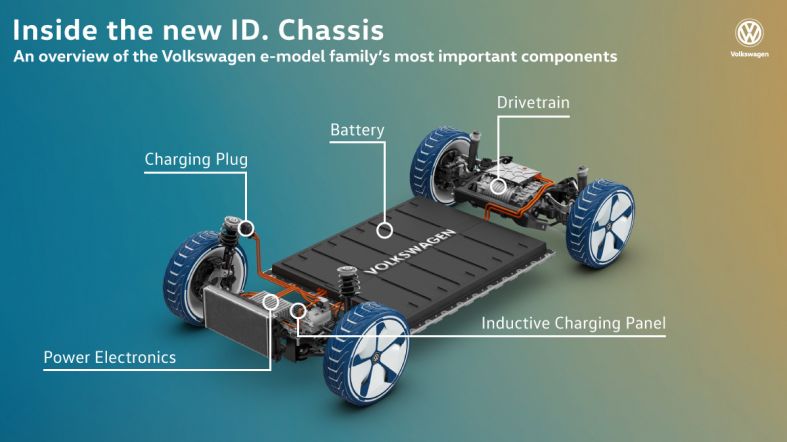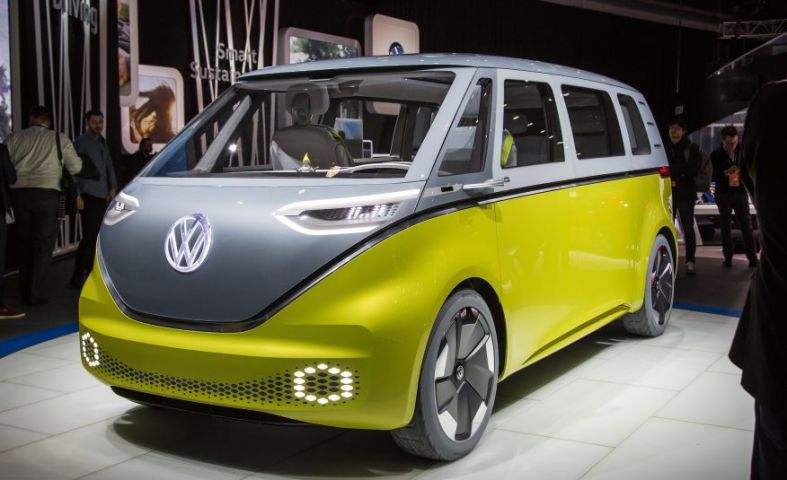A Closer Look at VW's MEB Platform, the Foundation for 10 Million Electric Vehicles
【Summary】 As VW shifts its focus to fully-electric models, the German automaker has build an entirely new modular platform to underpin its future vehicles. The new MEB platform represents an entirely new way of building cars at Volkswagen.

Although many vehicle models are designed to look different from each other, underneath their exteriors, automakers including Volkswagen, typically use shared mechanical components across various models to save costs and make the assembly process more streamlined. As VW shifts its focus to fully-electric models, the German automaker has build an entirely new modular platform to underpin its future vehicles.
Volkswagen has recently released details of its new MEB platform, on which ten million new electric vehicles will be built. The new MEB platform represents an entirely new way of building cars at Volkswagen. The new architecture consolidates all of the vehicle's electronic controls and reduces the number of microprocessors.
In German, VW's new platform is called the "Modulare E-Antriebs-Baukasten," which provides the source of its acronym at Volkswagen MEB. Translated, its name means "modular electric-drive toolkit". The MEB is designed to be the basic building block of the Volkswagen brand's electric transportation future beginning with the upcoming VW I.D. CROSS SUV and BUZZ minivan. Both models will be available in the U.S. market.
With Volkswagen's plans to produce 10 million electric vehicles using the modular MEB platform in a variety of styles, it becomes one of the most ambitious undertakings of any automaker. VW is not just adding an electric powertrain to an existing platform, instead the company has built its new platform from scratch—specifically for electric vehicles.
With the MEB "we have developed a platform designed specifically for electric cars," said Christian Senger, Head of the Volkswagen E-Mobility product line. "The I.D. models will not be combustion engine versions that have been converted, they will be designed to be 100 percent, thoroughbred electric vehicles. And they will be engineered to be online, upgradeable- and update-compatible. We're making optimal use of the possibilities this technology brings."
VW views its MEB platform as a "toolkit". The MEB isn't just the basic metal chassis, but the layout of key components and, most importantly, how they all fit together. Much like the Volkswagen MQB for its internal combustion engine models that underpins Volkswagen models from the Golf to the Atlas, the MEB can easily adapt to many different sizes of vehicles and battery capacities while using common components to help lower their costs.

An Overview of VW's MEB Platform
Designed for Electric Propulsion
Since the MEB toolkit was designed from the start specifically for electric propulsion, the MEB-based vehicles will have several innovations. Since electric motors take up less space than gas-powered engines and transmissions, the I.D. models can offer a much bigger interior space that's a class-size larger, in a vehicle with smaller overall dimensions.
For example, the upcoming I.D. CROZZ interior is about the same size as VW's full-size Atlas SUV, yet the vehicle's dimensions are similar to the company's compact Tiguan SUV.
The MEB platform allows VW to configure its upcoming electric models with either rear wheel or all-wheel-drive, using one or two electric motors, for more optimal weight distribution and better handling.
The battery pack, which is mounted low in the floor can be easily redesigned for different sizes and types of batteries, allowing for longer driving ranges from 200 miles up to more than 340 miles on the WLTP (Worldwide Harmonized Light Vehicles Test Procedure) cycle.
"The platform that Volkswagen is developing is more consistent and innovative than many of the other platforms," said Thomas Ulbrich, Member of the Volkswagen Brand Board of Management, E-Mobility division. "By 2022 alone, we anticipate that four Volkswagen Group brands will be ramping up 27 MEB models worldwide, ranging from compact cars to the I.D. BUZZ van."
By 2025, VW plans to sell as many as 3 million electric cars per year.

The VW I.D. Buzz concept on display at the 2017 LA Auto Show
In addition to shared electric powertrain components, the MEB can be designed to help make advanced technologies commonplace, such as providing over-the-air software updates and 125-kW DC fast charging.
Ulbrich compares the launch of the MEB to the transition VW made in the 1970s from the Beetle to the Golf, the small car that changed the company and transportation around the world. VW currently offers the e-Golf, an electric version of the company's popular hatchback. However, the car is built on the existing combustion engine platform, so compromises were made to outfit the Golf with an electric powertrain. This is not the case with the MEB platform, which is designed from the start for electric motors.
Christian Senger, Head of the E-mobility Product Line, says that the MEB, as a dedicated electric platform, will make it possible to install larger batteries.
"The ID. will be a milestone in technological development. It will be the first fully connected electric car with full everyday utility that millions of people will be able to afford. The car holds the road really well thanks to the flat battery in the floor pan and the space inside is much more generous. We are making substantial headway with the sense of spaciousness."
"The MEB modular electric drive matrix is probably the most important project in Volkswagen's history," he added.
To support its push to introduce new electric models VW plans to invest $7 billion upgrading its assembly plants. A majority of the funds will be used to upgrade the company's assembly plants in Braunschweig, Salzgitter and Kassel.
-


Ford is Testing a New Robotic Charging Station to Assist Drivers of EVs With Disabilities
-


Ford Raises the Prices of the F-150 Lightning Electric Pickup Due to Rising Raw Material Costs
-


The BMW 7-Series to Feature HD Live Maps From HERE Technologies for Hands-Free Highway Driving in North America at Speeds up to 80 MPH
-


AutoX to Use the 'Eyeonic Vision Sensor' from California-based SiLC Technologies for its Robotaxi Fleet in China
-


LG Develops ‘Invisible’ Speaker Sound Technology That Could Revolutionize In-Vehicle Audio
-


Researchers at South Korea’s Chung-Ang University Develop a ‘Meta-Reinforcement’ Machine Learning Algorithm for Traffic Lights to Improve Vehicle Throughput
-


Zeekr’s New 009 Electric Passenger Van is the World’s First EV to Feature CATL’s Advanced ‘Qilin’ Battery With a Range of 510 Miles
-


Redwood Materials is Building an Electric Vehicle Battery Recycling Facility in South Carolina
- Construction of Panasonic’s New EV Battery Factory in Kansas to Start in November
- Good Time to Buy Into China's EV Industry
- Munro and Associates Offers a Detailed Look of How the Front Seats of the Tesla Model Y Are Bolted to its Battery in New Video
- EV Charging Provider ChargePoint to Install Hundreds of Chargers at Apartments and Condo Complexes Across California
- Vietnam-based Electric Vehicle Startup VinFast Ships its First Vehicles to the U.S.
- Rivian, Mercedes-Benz Partner to Produce Electric Commercial Vans
- Hyundai Unveils the IONIQ 6 ‘Electric Streamliner’, its Bold Sedan With a 380-Mile Range and 18-Minute Charging Time
- Automotive Supplier MAHLE Developed a Superior Continuous Torque (SCT) Electric Vehicle Motor That Can Run ‘Indefinitely’
- Volvo Offers a Sneak Peak of its New Flagship EX90 Electric SUV Ahead of its Upcoming Reveal on Nov 9
- Toyota is Investing an Additional $2.5 Billion to Expand its North Carolina Factory to Boost EV Battery Production











 About Us
About Us Contact Us
Contact Us Careers
Careers